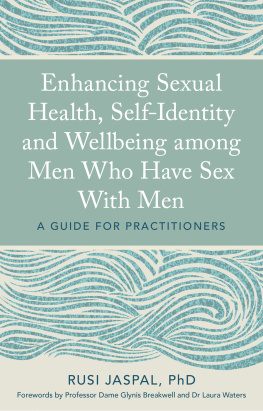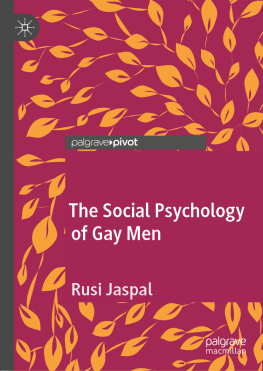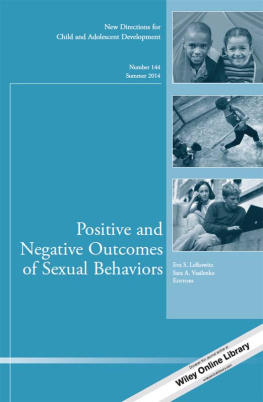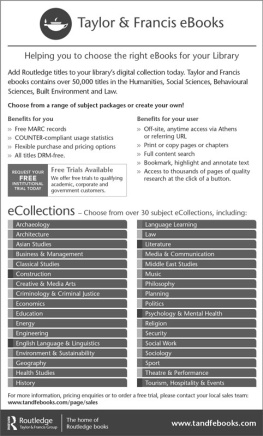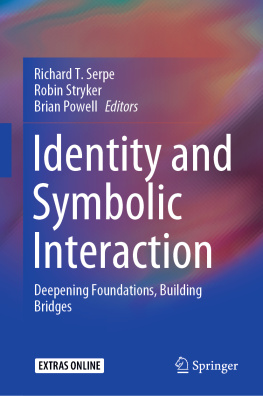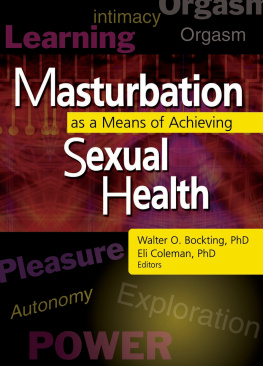
Enhancing Sexual
Health, Self-Identity
and Wellbeing among
Men who have Sex
with Men
A GUIDE FOR PRACTITIONERS
RUSI JASPAL
Foreword by Professor Dame Glynis Breakwell
Foreword by Dr Laura Waters

Jessica Kingsley Publishers
London and Philadelphia
Contents
Foreword
Professor Dame Glynis Breakwell
This book is about the role of identity processes in shaping the sexual health and wellbeing of men who have sex with men (MSM). It explores the complex reasons, rooted in culture and context, which underlie behaviours that might be misunderstood by observers or simplistically labelled reckless or self-harming. This is a book addressed to practitioners working to support the health and wellbeing of MSM. The book seeks to equip practitioners with methods derived from social psychological theories for explaining the behaviour of individuals, groups and communities who are at risk and who are asking for support. It argues that, used systematically and with common sense, these methods will enhance the effectiveness of the support that practitioners can offer and may result in enduring change for those in need of help.
Readers should be warned this is not a book that offers simple recipes for action by practitioners. It offers no one size fits all mantras or solutions. It does not strip down the social psychological theories that it presents to their bare skeletons in order to make them palatable. The introductions it offers of these theories are accurate and cover what is necessary to make them really useful to an experienced practitioner. Getting the best out of this book requires readers to reflect on their own practice and think through how they would have intervened differently in some of their past cases if they had used the methods suggested by Jaspal.
The book does not restrict itself to solely discussing social psychological models for practitioner intervention, the succinct summaries of current biomedical methods are also useful. However, Jaspal, not surprisingly given his eminence as a social psychological theorist, is particularly effective in describing the sources of stress experienced by MSM and the nature of the threats to identity that they generate. He uses identity process theory (IPT) extensively in this analysis. When I originally proposed the theory in the 1980s it was primarily as a way of understanding how people develop and deploy coping strategies when they are faced with a threat to their identity. Strangely, most researchers who have used IPT have been concerned with testing the model of identity structure and principles that it proposes. They have not focused on the analysis that it offers of the coping strategies that people use when threatened. In this book, Jaspal has used that analysis of coping strategies in a way that few other theorists attempted to do. For that I am personally grateful. It is about time that the emphasis turned to thinking about coping strategies. Without doubt, understanding and anticipating coping strategies is of prime importance to practitioners.
An essential ingredient in understanding coping strategies is to recognise that they can be very complex. They can reside in cognitive or emotional responses in the individual and they can be vested in the dynamic interactions between individuals and within and across groups in a community. This is probably why Jaspal argues that interventions to support people who face threats to identity should not always be individualised. His proposal that social representations theory can be used in concert with IPT to understand how sexual health and wellbeing among MSM might be enhanced is founded upon the argument that interventions can be better targeted if they take account of the communities in which the individual lives. Jaspal recognises the importance of communities in moderating the impact of practitioners interventions. He encourages practitioners to understand how those communities can be brought to bear upon the enhancement of interventions. One interesting exemplar he uses is the role of virtual, internet-based communities in the creation and maintenance of identity for MSM. Identity in these cases is embedded in an extended community which is digital a community which can be both a source of threat and of coping.
The approach towards the enhancement of sexual health and wellbeing suggested in this book is not only relevant to MSM. It is an approach which can inform any practitioner who is attempting to understand how to help any person facing identity threat. Threats to identity come in many, many forms - from physical injury to memory loss or from social stigmatisation to job loss. The lessons to be learned from this book are relevant to many contexts. A persons identity is a dynamic, evolving system being created over a lifetime. Supporting and channelling that evolution is often a most valuable task of a practitioner.
Glynis Breakwell
January 2018
Foreword
Dr Laura Waters
As a clinician working in sexual health and HIV, the disproportionate impact of sexually transmitted infections (STIs) on MSM, particularly from Black and Minority Ethnic (BME) communities, is an issue I face daily. Public Health Englands 2017 report highlighted that MSM and BME groups, along with young heterosexuals, experience the greatest impact of STIs. MSM form a small proportion of the UK population, yet account for the majority of syphilis and gonorrhoea cases. 2016 syphilis figures showed the highest rates of infection since 1949, and almost doubling since just 2012, mostly in MSM. This yielded many headlines. The same report illustrated the highest population STI rates amongst Black individuals, particularly those of Caribbean origin, and attributed this to a complex interplay of cultural, socio-economic and behavioural factors. Recent years have seen outbreaks of other STIs in MSM including the enteric infections Shigella and hepatitis A, the latter compounded by shortages of hepatitis A vaccine. Yet there was also some good news. The undetectable =untransmissible or U=U message, that is, individuals taking HIV drugs that render the virus undetectable on a sustained basis cannot transmit HIV to their sexual partners, really gained hold with even the Centres for Disease Control and Prevention (CDC) in the US supporting the message. Additionally, dramatic declines in new HIV diagnoses in MSM in England highlighted that better testing, earlier HIV treatment and targeted prevention (including PrEP) provide us with the tools to ultimately stop new HIV infections. However, eradication of HIV can be achieved only by diagnosing the 13% of people currently living with undiagnosed HIV in the UK. Barriers to testing related to ethnicity and self-identified sexuality are significant.
Having admired the work of Professor Jaspal on sexual risk-taking and the experiences of people living with HIV, and his awareness-raising related to the issues faced by BME MSM, it was an honour to be asked to write a foreword for this book! His publication on polarised press reporting related to HIV pre-exposure prophylaxis (PrEP) was particularly pertinent to someone who spent many months contributing to a subsequently abandoned NHS England policy an unfortunate triumph of fear of risk (and spending) over hope. I hope the PrEP Impact trial, borne of the original policy, will answer some of the ongoing questions related to PrEP use in BME communities.
This book describes, in an eloquent and approachable manner, the relationships between identity, sexual risk and wellbeing. The three cases summarised in Part 1 will be all too familiar to professionals engaged in sexual health care and STI prevention. As a doctor well versed in biomedical aspects of our specialty, this book was a sobering reminder that my knowledge and use of psychosocial questioning is limited. Part 2 highlights the psychological impact of social stressors, particularly the section on homonegativity, and, in the same chapter, a description of potential benefits of geospatial apps (so often associated with negative STI and drug use connotations) related to sexual identity and negotiation of condom use. The summary of counselling psychology was highly informative and the authors linking of different approaches back to the outlines how HIV practice can be enhanced by identity theory, focusing on PrEP and HIV medication adherence; the latter topic was a real wake-up for me that the advances in HIV drugs do not necessarily negate the barriers patients experience when expected to take the medication daily. Each chapter in Part 3 ends with a must-read section on implications for practitioners, with important lessons that I intend to incorporate in my teaching and my practice.
Next page
